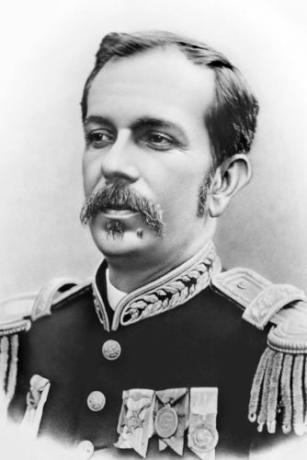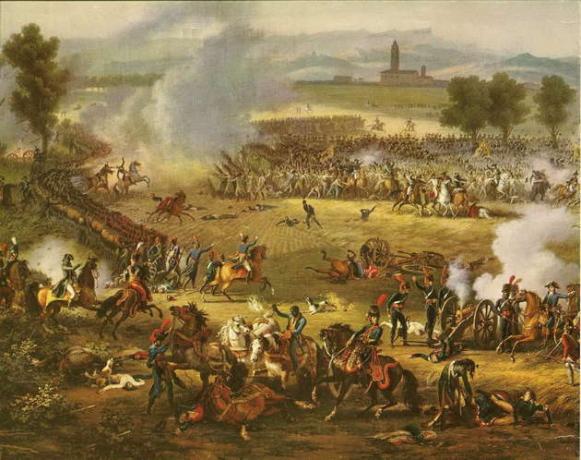THE Revoltgivesarmada, also known as the Second Armada Revolt, was an uprising organized by members of the Brazilian Navy in September 1893. This uprising was due to the dissatisfaction of these members with the government of Floriano Peixoto. They were defeated in March 1894.
read more: FORclaim of republic – military coup that marked the end of the empire in Brazil and the beginning of the republic
Armada Revolt Summary
The 1890s were marked as a period of consolidation of the republic and a lot of political struggle.
There was a strong dissatisfaction in the Brazilian Navy with the government of Floriano Peixoto.
The Navy had already rebelled for the first time, in 1891, during the government of Deodoro da Fonseca.
The Navy also did not agree with the way the Federalist Revolution.
The uprising took place in September 1893, there were bombings against Rio de Janeiro, but support for the Navy was low and the movement failed in 1894.
Context on the Revolt of the Armada
The Armada Revolt was one of the revolts that took place during the
period of consolidation of the republic in Brazil. This revolt is related to the political disputes fought in Brazil during this period, but also with the Armada (Navy)'s dissatisfaction with the government of Marshal Floriano Peixoto.It is important to consider that the Armada was a group that had already demonstrated its dissatisfaction with the governments established in our country after the change to the republican system. During the government of Marshal Deodoro da Fonseca, she had rebelled when the president decreed the closing of the National Congress.
This event is known by many as First Armada Revolt and took à resignation of Deodoro da Fonseca. The president decided to resign to prevent a civil war from breaking out in the country. This started the transition from vice to president.
By the Brazilian Constitution promulgated in 1891, a new election should be called within two years. O Vice President Floriano Peixoto assumed the presidency in a kind of political agreement to guarantee the stability of the republic. However, his government contributed to increasing the country's instability.
Floriano Peixoto was marked as a authoritarian president and that it intervened heavily in Brazilian politics to ensure its support in power. Peixoto appointed new presidents of states, negotiated the suspension of parliamentary work, declared a state of siege in 1892, among others.
All these events reinforced political disputes and the opposition of members of the Armada against the president. The decree of the state of siege, in fact, was an action by the president to contain a movement of general officers who issued a manifesto against him. This manifesto demanded that the president fulfill what the Constitution ordered and organize a new presidential election for Brazil.
Video lesson on revolts in the First Republic
Armada Revolt

A new revolt by the Brazilian navy took hold in 1893 and has a lot of relationship with the Federalist Revolution, civil war that happened in the south of the country. In this conflict, the Brazilian government supported the president of the state of Rio Grande do Sul, Júlio de Castilhos. He was fighting against opposing forces led by Gumercindo Saraiva, whose objective was to overthrow Castilhos.
It turns out that, in the course of that conflict, the president authorized the Admiral Custódio José de Melo's resignation as Minister of the Navy under the allegation that there was a need to reduce costs in the struggle being waged in the South. The resignation caused dissatisfaction in the admiral, who intended to run for president. Furthermore, he did not agree with the government's alliance with Julio de Castilhos. Thereafter, opposition to the government of Floriano Peixoto grew considerably in the Navy, and a number of issues can explain it:
Dissatisfaction with a possible devaluation of the Navy in relation to the Army;
Large presence of monarchies in the Navy.
The Navy's dissatisfaction with the government of Floriano Peixoto led to the beginning of the Revolt of the Armada, also known as the Second Revolt of the Armada, on September 6, 1893. The leaders involved in this new uprising of the Navy were the Admiral Custodio de Melo, besides the Admiral Edward Wandenkolk it's the Admiral Luís Filipe Saldanha da Gama.
The Armada rebels denounced the policy practiced by Floriano Peixoto, accusing it of strengthening the disputes regional policies that took place among Brazilian oligarchies, the case of the Federalist Revolution being the most evident. Furthermore, Floriano Peixoto was accused of having a corrupt government, and, finally, there was the mentioned dissatisfaction with the failure to call a presidential election by him and as agreed when he assumed the presidency.
With the beginning of the revolt, Navy vessels were positioned with their cannons pointed towards the RiverinJanuary, capital of Brazil, and Niteroi, capital of the state of Rio de Janeiro. The rebels had a force of 16 naval vessels and 14 civilian vessels. On September 13, the bombing began in Niterói and Rio de Janeiro.
With the beginning of the bombings, the capital of Rio de Janeiro had to be transferred to Petrópolis. The Armada Revolt is over not counting on popular membership, since the Brazilian population, in large part, supported the government of Floriano Peixoto, and the Army did not support it either.
There were also naval battles against Army troops in Niterói, but the Armada insurgents demonstrated that they did not have the capacity to conquer Rio de Janeiro, and the blockade they carried out in the city by sea was withdrawn. so they sailed to the sul of Brazil, with the objective of joining the federalists who were fighting Floriano Peixoto and Júlio de Castilhos, in Rio Grande do Sul and Santa Catarina.
Video lesson on Federalist Revolution
Outcome of the Armada Revolt
The rebels then headed to Exile (current Florianópolis) and they looked for join the federalists in the fight against the government, but the negotiations did not work out. Finally, the support that the government of Floriano Peixoto received from the United States contributed to the defeat of the Armada Revolt.
The American support to Floriano Peixoto was given because American ships were wrecked after being attacked by the insurgents. Thus, Floriano Peixoto received some boats designed in the United States. The end of the Armada Revolt officially took place in March 1894.
With the end of the revolt, Custódio de Melo went into exile in Buenos Aires and only returned to Brazil after receiving an amnesty, in the government of Prudente de Morais; Eduardo Wandenkolk was arrested during the revolt and was taken to the Santa Cruz Fortress, in Niterói, being released for amnesty, also during the government of Prudente de Morais.
Finally, Saldanha da Gama received asylum from the Portuguese government, which led to a diplomatic crisis between Brazil and Portugal. His asylum did not happen, and he joined the Federalists in the fight against Floriano Peixoto, dying in battle.
Image credits
[1] Commons



